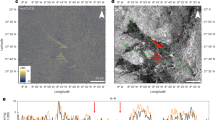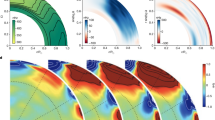Abstract
NEUTRAL wind measurements in the thermosphere have been made on many occasions using ground based photographic1 or photometric observations2 of artificial clouds released from rockets. These clouds are visible either through a chemiluminous reaction, such as with trimethyl aluminium (TMA) releases, enabling night-time observations to be made at altitudes between 80 and 150 km or through resonance emissions of sodium, lithium, barium or aluminium oxide when clouds are illuminiated by sunlight, enabling twilight or daytime observations to be made above about 80 km.
This is a preview of subscription content, access via your institution
Access options
Subscribe to this journal
Receive 51 print issues and online access
$199.00 per year
only $3.90 per issue
Buy this article
- Purchase on Springer Link
- Instant access to full article PDF
Prices may be subject to local taxes which are calculated during checkout
Similar content being viewed by others
References
Rosenburg, N. W., Golomb, D., and Allen, E. F., J. geophys. Res., 68, 5895–5898 (1963).
Rees, D., Neal, M. P., Low, C. H., Hind, A. D., Burrows, K., and Fitchew, R. S., Nature, 240, 32–33 (1972).
Bowman, M. R., Gibson, A. J., and Sandford, M. C. W., Nature, 221, 456–457 (1969); Gibson, A. J., J. Phys. E., 5, 971–973 (1972); Gibson, A. J., and Sandford, M. C. W., Nature, 239, 509–511 (1972).
Author information
Authors and Affiliations
Rights and permissions
About this article
Cite this article
REES, D., SANDFORD, M. Thermospheric winds from laser tracking of sodium clouds. Nature 252, 291–292 (1974). https://doi.org/10.1038/252291a0
Received:
Issue Date:
DOI: https://doi.org/10.1038/252291a0
This article is cited by
-
A steerable laser radar system for atmospheric studies
Optical and Quantum Electronics (1978)
Comments
By submitting a comment you agree to abide by our Terms and Community Guidelines. If you find something abusive or that does not comply with our terms or guidelines please flag it as inappropriate.



